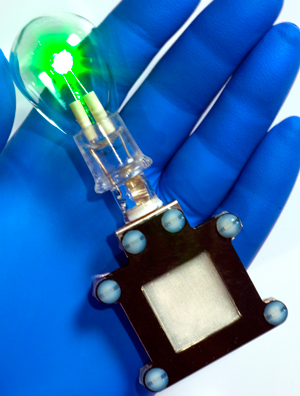Got A Battery Breakthrough? You Need Friends in Manufacturing
PolyPlus—a tiny, 27-person battery startup—has decided it needs to learn the ropes of volume manufacturing in order to bring its technology to market.

Earlier this week, the Berkeley, California-based company was awarded a grant, along with Johnson Controls and Corning, from the Department of Energy’s Innovative Manufacturing Initiative. The $9 million grant will fund a pilot line to make a key component for lithium-water, lithium-air, and lithium-sulfur batteries, new chemistries the company hopes will deliver a big jump in energy density over today’s batteries.
PolyPlus is one of dozens of companies pursuing better batteries, but its business model is different than most. It’s only taken money from investors with a long time horizon and it wants to make manufacturing, not just material science, a core skill.
Incremental improvements to lithium-ion batteries can be added onto existing production machines, but introducing a completely new chemistry with the potential for a breakthrough—something a number of other companies are trying to do—requires actually making the hardware, says CEO Steven Visco.
“Nothing like this has been done before, so when we license this it’s a lot more valuable when people can see the product and they can take products off of a working line. It gives us credibility in the marketplace and we can get feedback,” he says.
The first planned products will be non-rechargeable lithium seawater battery expected next year, followed by a non-rechargeable lithium-air battery a year after that. Using the same core technology, PolyPlus plans to make rechargeable lithium-air and lithium-sulfur batteries a few years after Visco says.
PolyPlus has steered clear of venture capital investors up until now because VCs look to exit startups within a few years, which doesn’t suit the energy storage business, Visco says. Instead, the company has operated on government grants and funding from large company investors. And it’s partnering with large companies around manufacturing.
“We’re small. It’d be tough to grow from a small company overnight and that’s a dangerous path. Johnson Controls brings a whole supply chain and skill set in high volume manufacturing,” he says.
If it can be manufactured at a reasonable cost, the technology could offer a pathway to major improvements in the amount of energy batteries can store by volume. The company’s seawater battery, which could be used for robotic underway vehicles or underwater sensors, will offer ten times the energy of today’s batteries, Visco says. The Army will begin soon testing PolyPlus’ primary lithium-air batteries to lighten the load for soldiers, he added.
The core technology for all its planned batteries dates back to 2003 when company engineers developed a ceramic membrane that only allows lithium ions to move through it but is impervious to water, air, or other materials. Having a sealed solid ceramic electrolyte allows the company to pursue lithium air and lithium sulfur chemistries, too, Visco says.
Its first lithium seawater batteries won’t be rechargeable but will have an energy density of 1,300 to 1,500 watt-hour per kilogram, several times what today’s batteries offer, according to the company. They won’t be as powerful as traditional lithium-ion batteries, but the better energy density will allow for much longer-lasting underwater missions for sensors or vehicles.
The company faces a number of technical hurdles, notably making its rechargeable batteries last many cycles, but Visco says the only way to get a leg up is to bet on a potentially disruptive technology and make manufacturing a core skill.
“To compete with lithium-ion battery makers takes billions of dollars of capital—it’s all volume manufacturing and you’re competing with ‘Asia Inc’. There’s going to be graveyards full of buried battery companies,” he says.
Keep Reading
Most Popular
Large language models can do jaw-dropping things. But nobody knows exactly why.
And that's a problem. Figuring it out is one of the biggest scientific puzzles of our time and a crucial step towards controlling more powerful future models.
The problem with plug-in hybrids? Their drivers.
Plug-in hybrids are often sold as a transition to EVs, but new data from Europe shows we’re still underestimating the emissions they produce.
Google DeepMind’s new generative model makes Super Mario–like games from scratch
Genie learns how to control games by watching hours and hours of video. It could help train next-gen robots too.
How scientists traced a mysterious covid case back to six toilets
When wastewater surveillance turns into a hunt for a single infected individual, the ethics get tricky.
Stay connected
Get the latest updates from
MIT Technology Review
Discover special offers, top stories, upcoming events, and more.